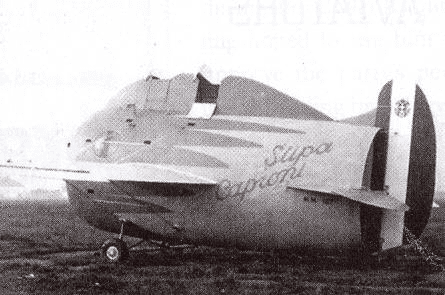NASA archives hold a pivotal technical memorandum inherited from its predecessor, the National Advisory Committee for Aeronautics, dating back to 1933. Would it shape the face of aeronautical engineering? Not exactly, though its inventor believed it to be a stepping stone to the modern jet engine. Would it introduce us to the fattest plane in the history of flying? Oh hell yes.
The Stipa-Caproni was the brainchild of Italian aeronautical engineer Luigi Stipa. With a background in hydraulic engineering, he theorized that hydrodynamic principles could be applied to flight. His musings culminated in a plane so bulbous it was nicknamed “the flying barrel” (epic poster here).
It might not seem like the most aerodynamic design, but there was method to Stipa’s aeronautical madness. His invention was wrapped around an “intubed propellor” that was mounted inside a hollow tube.

Imagine the paired engines of a modern plane, except in this case there’s just one, and the passengers are sitting on top of it. It sounds absurd, but it was Stipa’s way of applying Bernoulli’s principle to flight by creating a tube that could speed up the velocity of air passing through it.
The flying barrel was published in the Rivista Aeronautica (Aeronautical Review), reports HistoryNet, and after a petition to the Air Ministry a prototype was developed with the Caproni Aviation Corporation, hence the name Stipa-Caproni.
Stipa-Caproni took its first test flight on October 7, 1931, piloted by Domenico Antonini. It revealed that the airfoil shape of the intubed propellor not only improved engine efficiency but also contributed lift. You can see it taking off in all its bee-shaped wonder in the below video.
The plane was also incredibly light, but it did have its downsides.
The humped design of the flying barrel created so much aerodynamic drag that it cancelled out the perks of the intubed propellor. The result was a less-than stealthy plane that crawled through the sky at a maximum speed of 130 kilometers per hour (81 miles per hour). Not bad compared to the first ever plane that flew about 11 km/h (6.8 mph) – for 12 seconds – but much slower than other planes of the 1930s that were crossing the 322 km/h (200 mph) mark.
Being at such a raised position above the propellor also wasn’t ideal for the pilot, as the plane’s bulbous design got in the way of good visibility during take-off and landing. However, it was a lot quieter than conventional planes and needed a very short landing strip for its return to Earth that clocked an impressively modest 68 km/h (42 mph).
Beyond academic buzz around the results of the test flights, the Stipa-Caproni’s flying days were numbered. But the flying barrel lives on thanks to a functioning scale replica built by Lynette Zuccoli and Aerotect Queensland in Australia, and hoo boy, is it majestic.
Source Link: This Cannoli With Wings Could Fly... Very Slowly